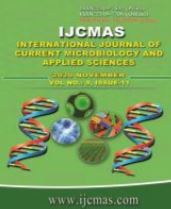


 National Academy of Agricultural Sciences (NAAS)
National Academy of Agricultural Sciences (NAAS)

|
PRINT ISSN : 2319-7692
Online ISSN : 2319-7706 Issues : 12 per year Publisher : Excellent Publishers Email : editorijcmas@gmail.com / submit@ijcmas.com Editor-in-chief: Dr.M.Prakash Index Copernicus ICV 2018: 95.39 NAAS RATING 2020: 5.38 |
The study applied the soil, land and topographic data for analyzing the potentiality of land for trees /crops suitability in the Gumla district of Jharkhand, India. The remote sensing, GIS and GIS modeling techniques were used to achieve the goal. The soil fertility, soil wetness, and slope map are scientifically produced and integrated to find out the landscape suitable categories for prioritization of trees/crops scaling in the agroforestry domain. Additionally, we have examined the drift of loss of soil wetness using satellite data from monsoon to post-monsoon period up to the village level. The analysis logically revealed the potentially suitable landscape (28%: high; 38%: medium; 25%: low and 9%: very low) for tree/crop farming. The seasonal drift of soil moisture loss after monsoon season was found highest in village Mahugaon followed by Pahladpur, Jalka, Itkiri, Shiwserang, and Gamhariya. Furthermore, 40% of the total villages of the study area showed soil wetness loss from medium to very high during the same base period which needs intensive soil and water conservation measures at the watershed level to conserve seasonal rainwater. These efforts will improve the soil moisture and water availability for plants and support significantly in extending agroforestry exercise/design/ management locally. Such analysis/results are one of the potential research gaps can be harnessed for the betterment of cultivators/farmers in the tribal-dominated region using local knowledge for designing appropriate agroforestry practices/models and can be incorporated in various ongoing and future projects.
 |
 |
 |
 |
 |